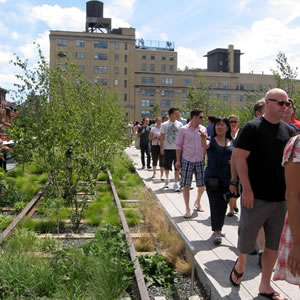
Ten years ago, a group of community advocates approached New York's City Council with a novel idea: why not convert an abandoned elevated railroad track in Manhattan’s meatpacking district into a public park?
When I went to check out the finished product shortly after it opened last month--along with crowds of joggers, families, and tourists snapping photos of the gritty waterfront below--I was pleasantly surprised to find that the railroad tracks had been left intact, sprinkled with native grasses and wildflowers. Even the structure's wrought iron railings, faded in some sections, had been preserved.
It dawned on me: not only had the 70-year-old rail line, known as High Line Park, escaped the environmentally unsound fate of demolition, but it had been recycled, its structural elements reconfigured into something modern, practical, and accessible to the public.
The technical term for this type of initiative is adaptive reuse. Such projects were initially undertaken for experimental and perhaps cost-saving purposes. Examples abound: Boston’s historic City Hall was converted into a restaurant and office space in the 1960s; an abandoned crayon and pencil factory in Jersey City was fashioned into an apartment complex two decades later; London’s Tate Museum, opened in 2000, was once a power plant.
Whereas earlier projects were created for cost-saving and artistic purposes, more and more industrial relics are being retooled with sustainability in mind. The goal is to conserve energy and materials, while preserving historic architecture and maximizing public utility.
Developers in New Orleans, for instance, are converting a historic skyscraper into a mixed-use space as part of a broader effort to redevelop the hurricane-ravaged city in an environmentally sound manner. With over 100 apartments and 11,500 square feet of ground-floor retail, the former Shell Oil headquarters, built in 1952, will be seamlessly incorporated into downtown New Orleans’ fabric.
In Chicago, a group of preservationists is in the process of converting one of the city's first public housing projects-- boarded up since 2002-- into an interactive museum. And railroad parks inspired by the High Line’s design are in the works in Philadelphia, St. Louis, Chicago, and Jersey City.
The projects are numerous and exciting, but they could use more help from local governments. Imagine citywide, countywide, or even statewide “building recycling” programs that would provide incentives or subsidies for the conversion of industrial infrastructure into something fresh.
Such programs would boost the green jobs sector and the hard-hit construction industry. They would also support other aspects of the environmental movement. Shuttered automobile factories, for instance, could be quickly and efficiently transformed into, say, centers for clean energy research. Although this might sound like a pipe dream, if Friends of the High Line (the group behind Manhattan’s railroad park) were to take another proposal to City Hall, the project might not take a whole decade to come to fruition.

